Social and economic development. Рубрика в журнале - Economic and Social Changes: Facts, Trends, Forecast
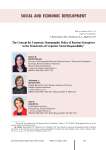
Статья научная
National priorities in the development of Russian society in the field of demography are related to population reproduction, health preservation, decrease in working-age mortality, increase in life expectancy, etc., and also correlate strategically with the effective functioning of business. This brings to the fore the need to develop, implement and elaborate on corporate social policy in general and corporate demographic policy in particular. The aim of the study is to analyze social policy pursued by major Russian corporations (PAO Severstal, Magnitogorsk Iron & Steel Works PJSC, Gazprom Neft PJSC, PJSC Lukoil, JSC Russian Railways, PJSC PhosAgro, PJSC Acron) and substantiate the concept for corporate demographic policy of enterprises. We consider prerequisites for the establishment and implementation of corporate demographic policy in Russian society. We have found that at the present stage of its development, corporate social responsibility is most often reduced to cash payments and participation of enterprises in individual social projects. The article analyzes social policy practices that Russian companies are implementing and that are directly related to demographic issues (childcare allowances, employee benefits, health resort treatment, etc.). We look into the approaches to understanding corporate demographic policy and its effectiveness; we show the benefits of implementing corporate demographic policy at Russian enterprises. Such benefits include promotion of business reputation, reduction in social tension, participation of enterprises in addressing demographic development issues, etc. According to some studies, the introduction of corporate health promotion programs can reduce disability losses from a number of causes by almost 30%. The practical significance and scientific novelty of our research consists in the development of a concept for corporate demographic policy of Russian enterprises, definition of its targets, implementation mechanisms and substantiation of the expected results, which consist in enhancing the effectiveness of state demographic policy as a whole and improving the results of implementation of corporate programs.
Бесплатно
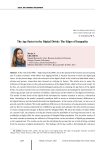
The age factor in the digital divide: the edges of inequality
Статья научная
At the end of the 1990s - beginning of the 2000s, due to the spread of the Internet at an increasing rate in certain countries, while others were lagging behind, it became necessary to study the digital gap issues. At the present stage, when the existence of the digital divide in the world and individual states is obvious and proven, researchers have focused on studying its factors. The article aims to assess the influence of the age factor on the scale and prevalence of the digital divide within a three-level model. To do this, we consider theoretical and methodological approaches to studying the age factor of the digital divide; we analyze trends in the use of information and communication technologies by representatives of various age groups, and the inclusion of children, adolescents and the elderly in the digital environment. The model of three levels of the digital divide developed by modern scientists is used as a theoretical basis. According to the model, inequality manifests itself in access to technical means, differences in the digital literacy, and the benefits derived from digitalization. In the course of the work, we use a set of general scientific methods. We reveal significant differences in the practices of using personal computers and the Internet among representatives of different age groups and calculate the time periods necessary to reduce intergenerational gaps in Russia and the Vologda Oblast. We assess the impact of online habits on a person’s life, the purposes of using the Internet and the possibility of receiving bonuses from it, the availability of digital skills for various age groups of Vologda Oblast population. The scientific novelty of the study consists in assessing the influence of the age factor on the prevalence of digital gap parameters at the regional level. The results can be used for identifying the groups that are at risk of being excluded from the processes of digital development. The findings will be also useful in formulating the relevance of social retraining programs for the able-bodied population in accordance with the requirements of new jobs, in teaching older people digital skills, and in making managerial decisions for successful digital development.
Бесплатно
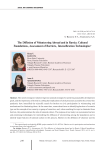
Статья научная
The need to integrate volunteering into national strategies for achieving sustainable development goals, and the importance of its role in curbing the implications of crisis processes caused by the coronavirus pandemic have intensified the scientific search for barriers to civic participation in volunteering and mechanisms for eliminating them. At the same time, researchers focus on identifying barriers of a certain type on the example of one country or group of countries, and, when searching for ways to eliminate those barriers, they underestimate the role of national culture. The purpose of our study is to systematize barriers and promising technologies for intensifying the diffusion of volunteering among the population and to identify major features of national culture in this process. Barriers to the diffusion of volunteer activity in society are systematized into three groups: barriers on the part of the state, barriers on the part of the non-profit sector, and barriers on the part of the individual. We show national features of their formation, which proceed from the specifics of emergence and evolution of volunteerism in the course of socioeconomic development. Using the postulates of institutional economic theory, we identify a system of institutions that intensify the diffusion of volunteering in society, including institutions for the promotion of volunteer practices, institutions for the development of civil society, institutions for the development of horizontal ties through network mechanisms for the diffusion of norms of civic participation, institutions for improving the reputation of volunteering among the population, the institute of volunteer education, institutions for increasing the motivation of participation in volunteering. On the basis of econometric analysis, we have determined that the cultural dimensions highlighted by G. Hofstede, such as the level of individualism, femininity and tolerance, have a significant impact on the extent of development of volunteering in the country. Taking into account the identified cultural features and effective technologies that promote residents’ engagement in volunteer activities, we determine directions for intensification of this process in Russia. Development of a comprehensive system of institutions for the diffusion of volunteering in our country will be a promising area for our future research.
Бесплатно
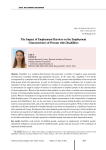
The impact of employment barriers on the employment characteristics of persons with disabilities
Статья научная
Disability is a complex phenomenon that generates a number of negative socio-economic consequences including working-age population decrease. At the same time, disability is not always accompanied by a complete loss of the ability to work. Usually, persons with disabilities of the second and third groups retain the opportunity to work in the presence of suitable conditions, but in practice the realization of their labor potential is limited by a number of circumstances. The purpose of this work is to substantiate the negative impact of barriers to employment of disabled people on the characteristics of their employment. Based on the statistical data analysis, we have shown a modern socio-demographic portrait of working disabled people, and analyzed the characteristics of their employment and economic activity. We have found that for a long period the highest economic activity was shown by persons with the third disability group. The paper proves that their higher representation in the composition of employed persons with disabilities is due, on the one hand, to less pronounced health disorders and relatively low need to create specialized jobs, and on the other hand, has economic prerequisites. We have shown that the realization of the labor potential of disabled people is not always accompanied by a significant increase in their material well-being. Employment for some disabled people may be a forced step, which confirms the prevalence among them of employment not in their specialty, as well as on the basis of an oral agreement, without official employment. The final part of the article outlines recommendations that can contribute to the fuller realization of the labor potential of disabled people and improve their financial situation.
Бесплатно

The impact of intergenerational differences on employee engagement in an organization
Статья научная
The relevance of the study is driven by the need to adapt corporate engagement policies to the specifics of the workforce’s age structure, especially in the context of demographic aging and the growing share of employees from Generations Y and Z. The aim of the work is to identify the specifics of how employees of different generations perceive engagement programs, using an industrial enterprise operating in a special economic zone as an example. In the scientific literature, engagement is interpreted as a multidimensional construct encompassing emotional, behavioral, and cognitive components; however, the generational aspect remains understudied. The novelty of the research lies in the empirical comparison of the levels and semantic characteristics of engagement among representatives of Generations X, Y, Z, and older employees, based on the validated international Kincentric model. The empirical base includes the results of a questionnaire survey of 72 employees of “SEZ ‘Titanium Valley”’ JSC conducted in the spring of 2025. An adapted questionnaire was used, comprising 24 statements grouped into four blocks: Engagement, Management, Resources, and Development. Percentage values were calculated based on the number of respondents who answered each question. Methods of descriptive statistics and intergroup analysis were applied. The obtained data indicate the highest level of engagement among Generation Y and a decrease in indicators among employees aged 56 and older. Differences in career expectations and perceptions of the corporate environment were identified. The practical significance of the study lies in the formation of personalized HR strategies for a multi-generational workforce. The limitations of the study are associated with the territorial specifics and the single-organization sample; promising directions for future research include expanding the geographical scope and comparing industry-specific cases.
Бесплатно

Статья научная
The relevance of the research topic is due to the growing impact of precarity on the quality of employment and standard of living among generational groups of economically active population. The opportunities and threats of current employment associated with standard of living may be manifested differently in these generational groups, especially among representatives of the middle generation. Information base of the study is compiled on basis of representative data from the Russia Longitudinal Monitoring Survey of HSE (RLMS-HSE) for 2021. A sample has formed among employed and unemployed people of the middle generation in age from 36 years up to retirement age. The results obtained denote that the presence of a high level of education and specialized ICT skills enables qualified representatives of the middle generation to ensure sustainable employment and minimize precarity risks. In general, a higher level of ICT skills increases the possibilities of the middle generation to apply their present labor capacities in the labor market. It was discovered that precarious employment is found not only in poor population. It is common among all social groups according to living standards, while it is most evident among low-income households of middle generation workers with per capita incomes of 1-2 subsistence minimums. Taking into account the position of middle-generation people in employment, their qualification and educational characteristics, as well as level of ICT skills, this research has produced some recommendations, which will contribute to neutralize precarity threats and implement professional potential of middle-generation workers in order to enhance living standards of their households.
Бесплатно

The impact of precarization on the standard of living and employment situation of Russian youth
Статья научная
The study of precarization implications focuses on young people who are facing serious problems on the way to stable employment. The lack of clear competitive advantages in the labor market complicates employment in the formal sector of the economy, where workers have access to an extensive system of social guarantees. In this regard, young people often feel vulnerable and uncertain about their future. Despite the relevance of the problem and wide discussion, there are not many specific empirical studies in this area. The aim of the paper is to determine the impact of precarization on the standard of living and the employment situation of young people. The information base is represented by the data of the Russia Longitudinal Monitoring Survey conducted by the Higher School of Economics for 2021 (30th round). Based on the original toolkit, the scale of precarious work was estimated depending on the concentration of precarization indicators and taking into account individual parameters of respondents. The indicators were calculated using the method of multivariate frequency distribution of attributes. According to the results obtained, the overwhelming majority (almost 80%) of young people are involved in precarious work. To a much lesser extent, this applies to the part of youth that has a high level of education, ICT skills and is engaged in skilled labor. The depth of precarization penetration is also closely linked to per capita income. As its size increases up to two subsistence minimums, the share of those involved in precarious work decreases significantly; and in this regard it does not matter what part of income is used for consumption. In conclusion, we substantiate proposals to counter the threats of precarization for young people. Prospects for further research are connected, first of all, with the identification of educational and professional trajectories that have a negative impact on employment stability.
Бесплатно
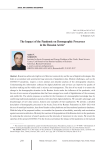
The impact of the pandemic on demographic processes in the Russian Arctic
Статья научная
Russia has achieved a high level of Internet connectivity and the use of digital technologies; this helps to accumulate and systematize huge amounts of population data. Modern challenges, such as the COVID-19 pandemic, require a more prompt and detailed analysis of the demographic situation. Understanding the information collected by digital platforms and services can improve the quality of decision-making and be widely used in science and management. The aim of our study is to assess the change in the demographic situation in the Russian Arctic under the influence of the pandemic, with the use of new sources of population data that have emerged as a result of digitalization of the economy and public life. The article proposes an outline for the formation of a demographic knowledge base by combining traditional population statistics with data from digital platforms. We consider advantages and disadvantages of new data sources, features and examples of their application. We provide a detailed description of demographic processes in the Arctic Zone of the Russian Federation in 2020-2021 with the use of municipal statistics, data from Yandex online platforms and international pandemic databases. With the help of the proposed outline, we consider the dynamics of morbidity, mortality and vaccination against coronavirus infection. We study the reaction of the population of the Russian Arctic to the pandemic by analyzing the structure of search queries and the intensity of movement in city streets. We reveal the specifics of the spread of COVID-19 in the Arctic and estimate the impact of the pandemic on the natural population change and human mobility in the Arctic Zone. We calculate excess mortality at the regional and municipal levels. Based on the vaccination rates, we draw conclusions about the prospects for further development of the pandemic. The results obtained can be used for development of socio-demographic policy measures and construction of demographic forecasts for the Northern and Arctic territories.
Бесплатно

The importance of corporate social services for the sustainable development of the company
Статья научная
In the context of modern global challenges such as social inequality, environmental degradation and limited availability of social services, the importance of corporate social policy is increasing. Companies strive not only to enhance financial stability, but also to create favorable conditions for their employees and society as a whole. In this context, corporate social responsibility (CSR) plays a special role, including corporate philanthropy, social initiatives, and infrastructure development to improve the quality of life. The article analyzes key aspects of CSR, in particular corporate philanthropy, clarifies the content of this concept, and focuses on the experience of its implementation by PJSC Tatneft in the framework of CSR, on the basis of which a sociological research program has been formed. To identify the factors determining the success of social policy in the provision of corporate charitable services, calculations were performed in the R environment through command queries. We propose a model that helps not only to quantify the current level of social policy, but also identify key areas for its improvement in order to increase employee satisfaction. The paper examines the impact of digitalization on the effectiveness of corporate philanthropy: in the context of the digital transformation of the corporate environment, new management approaches are being formed, which contributes to scalability and integration into long-term sustainable development strategies. The methodological basis of the research includes analysis of scientific literature, regulatory documents and practical cases. We also use economic and statistical methods, correlation and regression analysis, scenario forecasting to assess the prospects for the development of corporate charitable services. Findings of the research confirm the positive impact of social policy on the long-term development of enterprises and the formation of a sustainable business model. The recommendations we propose can be useful for companies seeking to improve their corporate social responsibility system and implement effective corporate philanthropic initiatives
Бесплатно

The importance of research on reproductive intentions for fertility forecasting
Статья научная
In the context of depopulation and demographic aging, the importance of forecasting population dynamics is increasing. Due to the high behavioral determinism of fertility, special attention should be paid to reproductive intentions, since they play an essential role in shaping birth rate, which in turn determines population reproduction by more than 90%. Research on reproductive behavior is carried out at both the federal and regional levels, which indicates that the array of data on reproductive intentions and their implementation has been accumulated. The aim of the work is to assess the possibility of using data on reproductive intentions in forecasting fertility. Based on the data from a reproductive plans survey carried out by Rosstat, we assess the prospects for using the empirical indicator "expected number of children", modifying it to "expected number of more children" if the parents already have children, in comparison with the number of children born during the period in question in real generations of women born in 1970–1994. The findings of the research indicate a fairly high stability of the gap between the expected and actual number of children, which suggests the possibility of using information about reproductive intentions in order to predict fertility. We reveal that for the generations who completed fertility the mentioned difference was 0.19, for women of the last fifteen (out of 35) years of fertility – 0.3. For women under 35, the gap is more significant – 0.72. We substantiate the possibility of using data on reproductive intentions to predict births of various order, which is especially important when planning the total fertility rate and the proportion of large families. The results obtained expand methodological foundations for forecasting fertility, which is of practical importance for improving the effectiveness of family and demographic policy in Russia.
Бесплатно
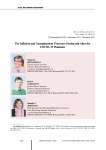
The inflation and unemployment processes during and after the COVID-19 pandemic
Статья научная
The article considers the features of the dynamics of the main macroeconomic indicators in related developing economies during the economic crisis and after it. Latin American countries (2020- 2022) are the object of the study. The aim of the work is to empirically verify the presence and closeness ofsignificantrelationships betweenthe processesofinflationand unemployment, includingthe possibility of taking into account other macroeconomic variables affecting the processes of inflation and unemployment during and after the COVID-19 pandemic. The relevance of the study is determined by the possibility of monitoring the development of the economic crisis. The analysis of linear regressions on pseudo-panel data was carried out. The general model took into account the size and features of the economy, economic policy, as well as some social effects (the dynamics of unemployment and inflation, specific mortality due to coronavirus, the size of the labor resources for the economy). The models constructed help to study the general crisis dynamics and show the rate of recovery for the trends. The novelty of the results includes an assessment of the effectiveness of management tools in the context of strong external shocks. It is empirically confirmed that there was no direct relationship between the processes of inflation and unemployment in Latin American countries during the period under consideration. A detailed analysis of the impact of macroeconomic factors and factors reflecting the behavior of state institutions may be useful for considering the risks of anti-crisis measures. Inflation is the most controllable process that can be influenced by tools. Unemployment, as a subject of regulation, is a more complex process involving various state institutions; at that, the success of decisions depends mainly on taking into account the country’s export specialization, the pace and severity of anti-crisis measures.
Бесплатно
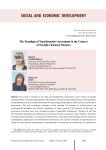
The paradigm of transformative investment in the context of socially oriented theories
Статья научная
The article is devoted to the study of transformative investments in the context of socially oriented theories. The growing inequality of the regions, the lack of equal opportunities in obtaining basic vital goods force society to look for new forms of overcoming social problems, which include transformative investments. The new investment paradigm, which provides for investing in solving social and environmental problems, has become widespread in many countries, the potential of this type of investment is growing every year, meeting the goals of sustainable development. Despite the fact that the investment directions of transformative investments involve investing in various spheres, this article considers only social aspects. In connection with the above, the purpose of the proposed work is to present a paradigmatic justification of transformative investments in the context of socially oriented theories. It should be noted that the phenomenon of transformative investments can theoretically be explained in the context of different theories and concepts, depending on research tasks. In this paper, the theories of social justice and social policy, the theory of the welfare state are considered. To understand the essence of transformative investments, the paper considers their main characteristics, which allowed reflecting the specifics of these investments and the features of their evaluation. Transformative projects are aimed at solving a significant social problem, they must bring financial returns and ensure guaranteed profitability, which distinguishes them from projects provided by charity or state support. The scientific novelty of the work lies in the fact that this group of theories (along with other theories) can serve as a theoretical platform for the study of transformative investments aimed at the development of the social sphere, complementing the works of Russian and foreign scientists. The results of theoretical studies conducted by the authors determine the choice of the main directions and forms of investments that allow optimizing the social policy of the state. The paper concludes that it is necessary to maintain a balance in the social and economic spheres, taking into account the already established institutions and preventing abrupt changes in the redistribution of income; providing the population with appropriate tools and its active participation in development processes.
Бесплатно
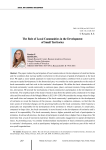
The role of local communities in the development of small territories
Статья научная
The paper studies the participation of local communities in the development of small territories and the conditions that increase public involvement in the processes of spatial development at the local level. We apply a socio-spatial approach to study local communities combined with an action-activist concept to spatial development. In the theoretical part, we consider the main approaches to the study of local communities and their role in the territories’ development. We define the basic characteristics of the local community: social community; a common space, place; common interests, living conditions; ties, interaction. We provide the mechanisms of local community’s participation in the development of territories. The empirical part of the study is based on data from the opinion poll, conducted in two large cities and five small ones of the Vologda Oblast in 2021 (N=1550). We consider the average values for large and small cities and compare the indicators of the local community’s participation in the development of territories to reveal the features of this process. According to subjective estimates, we find that the main actors of territorial changes are the governing bodies and the local community, while business is practically not responsible for the development of the territories in which it operates. In small cities, compared to large cities, the local community is more focused on the development of territories and is aware of its responsibility. The local community shows a higher potential and level of participation in initiatives. In almost all practices, the share of participants in small cities is higher than in large cities. We determine that a lack of teamwork experience hinders community engagement in spatial development issues. As promising areas, we consider institutionalized mechanisms of local community participation in territories’ development, such as participatory budgeting and project activities as part of the work of non-profit organizations.
Бесплатно
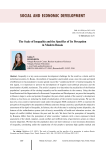
The scale of inequality and the specifics of its perception in modern Russia
Статья научная
Inequality is a key socio-economic development challenge for the world as a whole and for individual countries. In Russia, the problem of inequality is particularly acute, since the scale and depth of differences in the population’s income greatly exceed the “conditional levels” of normal inequality. In this regard, it is important to prevent the development of negative socio-political processes and the deterioration of public sentiments. The article’s purpose is to determine the peculiarities of the Russian population’s perception of the existing inequality and its manifestations in the country. Using the data from Rosstat and the Organization for Economic Cooperation and Development, we prove that inequality in Russia is large in scale and persists throughout the post-reform period of the country’s development without a clear focus on reducing the depth of polarization of the extreme income groups. We use the data of a cross-country representative study under the program ISSP, conducted in 2019, to examine the perception of inequality by the population of Russia and some foreign countries, specifically the subjective assessment of the depth of inequality, its fairness, the role of the state in reducing income disparities, the features of the redistribution system (role of taxes), accessibility of health and education services, the degree of conflict (dislike) between the poor and the rich. We show that the perception of inequality by Russians differs from the perception of other countries’ residents with a more expressed critical assessment of the depth, injustice, social conflict and ineffectiveness of government actions to reduce income disparities. We find that the population does not show tolerance to non-monetary dimensions of inequality, considering unfair the opportunity of rich people to purchase high quality medical and educational services. We reveal that there are no significant differences in the perception of inequality in different socio-demographic and socio-economic groups of the population. Attention is drawn to the fact that the subjective perception of inequality lies to a greater extent in the field of ideas about a fair social order than it is unambiguously determined by the level of income.
Бесплатно
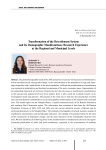
Статья научная
The global demographic trend of the 20th and early 21st century was the process of urbanization, which manifested itself, among other things, in the concentration of the population in large and superlarge megacities with a rapid decline in the rural population. In Russia the transformation of resettlement was expressed in polarization and localized compression of the socio-economic space, fragmentation of the supporting framework of territories. Despite the fact that the issues of resettlement transformation at the national and regional level have been studied, there is still a need for in-depth research on its intraregional trends and patterns. The purpose of the work was to look into the peculiarities of urban and rural resettlement transformation and its demographic manifestations at the regional and municipal level. The model region was the Vologda Oblast, a typical constituent entity of the Russian Federation and northern Non-Chernozem region. The information base consisted of data from the All-Russian Population Censuses of 2002, 2010 and 2020, and the current statistical records of Rosstat and its territorial department in the Vologda Oblast. The methods of cartography, structural-dynamic analysis of resettlement characteristics and demographic indicators, the typology of municipal entities by the ratio of the components of population change, and the main indicators of the demographic situation were used. We have identified the following trends in the transformation of resettlement systems in the region: increasing polarization of urban and rural resettlement, expressed in the concentration of residents either in large or in small settlements; depopulation of rural areas; weakening of the supporting framework of urban resettlement (system of small towns); strengthening “focality” rural settlement. In more than half of the Vologda Oblast municipal entities the urban and rural population decrease is caused by the double effect of natural and migration losses. At the same time, the number and the share of such municipalities have grown significantly over the past 20 years. Some municipalities have the potential of migration growth or age structure, but only in Kaduysky District there is an increase in population due to the migration growth of urban residents. In the conclusion the threats and opportunities for development for different types of municipalities are outlined.
Бесплатно
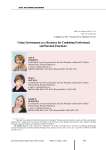
Urban environment as a resource for combining professional and parental functions
Статья научная
In the context of approving the “quality of life” concept, the formation of accessible and comfortable living environment is mentioned in Russia's national projects and in Russian towns' development programs. The purpose of the study is to analyze the quality of urban environment in terms of infrastructure conditions, located within walking distance, that minimize physical, material, and time costs of parents' forced daily mobility for educating and developing children. The scientific novelty of the study is related to the first-implemented approach to considering urban environment of residential neighborhoods as a resource for combining professional and parental functions. The empirical basis includes data of a mass survey of citizens-parents conducted in the megalopolis (Yekaterinburg) and the results of in-depth interviews with mothers of preschool and school-age children. The results of the study show a high subjective significance of territorial proximity of key child infrastructure facilities for successful combination of parental and professional functions. Moreover, it indicates a direct interconnection between the saturation of residing places with children's infrastructure facilities and overall satisfaction of parents with the quality of urban environment. The authors record the highest forced mobility due to the lack of walking distance services in the field of intellectual, creative, and sports development of children. A total number of deprived urban neighborhoods and the share of parents who are forced to use infrastructure services outside their neighborhoods indicate that there are spatial inequalities in access to urban goods. Practical significance of the study is the scientific justification of the need to develop comprehensive programs for the formation of a functionally rich environment in microlocal territories during the adoption of a progressive model for the development of a megapolis - “a network of 15-minute cities”. The authors conclude that hyper-proximity-accessibility of urban services can be a significant resource (in a broader social policy for supporting families) for successful combination of parental and professional functions, ultimately contributing to improving the quality of life of citizens with children.
Бесплатно
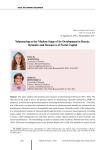
Статья научная
The paper analyzes the dynamics and resources of volunteering in Russia for 2016–2024. The relevance of the study is due to the growing interest in volunteering, especially during the COVID-19 pandemic, as well as active government support, including the federal project “Social Activity”. The main aim of the work is to study the involvement of citizens in volunteering and identify key resources for its development, taking into account demographic and social changes. Scientific novelty of the research lies in a comprehensive analysis of volunteering through the prism of a resource-based approach, including social capital. The transformation of forms of volunteering from traditional to digital and occasional is shown, which distinguishes the work from previous studies. Special attention is paid to gender and territorial imbalances. The methodology includes an analysis of the results of a Rosstat labor force survey (2016–2024) and a sociological study in the Tyumen Region (N=1,430). The methods of structural and dynamic analysis, clustering, as well as statistical criteria (χ2, Student's t-test) are applied. The number of volunteers in Russia has tripled, despite its population decline. Such activities as fundraising, social assistance and animal welfare prevail, but their coverage does not exceed 3% of the population. A gender bias has been identified: women make up 72% of volunteers and spend more time volunteering. Engaging in volunteering depends to a great extent on social capital (trust, membership in organizations). The limitations of the study are related to incomplete representativeness of the data and predominance of government sources. Prospects for further research include studying the motivation of men, the effectiveness of digital volunteering formats, and development of programs for young people and retirees
Бесплатно
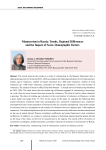
Volunteerism in Russia: Trends, regional differences and the impact of sociodemographic factors
Статья научная
The article presents the results of a study of volunteering in the Russian Federation from a regional perspective for the period 2022–2024 according to the following indicators: level of volunteerism, median age of volunteers, number of female volunteers per 1,000 male volunteers, number of rural volunteers per 1,000 urban volunteers, proportion of working-age volunteers in the total number of volunteers. The analysis is based on official data from Rosstat – a sample survey of volunteering workforce for 2022–2024. The study shows that the median age of Russians engaged in volunteering is increasing. As a rule, there are more women than men among the volunteers. The ratio of rural to urban volunteers is growing. The share of working-age volunteers in the total number of volunteers in Russia as a whole is quite stable and ranges from 73–74%. In the course of the study, we calculate the following labor market indicators: volunteers’ labor force participation rate, volunteers’ employment rate, volunteers’ unemployment rate (or the proportion of volunteers who are currently unemployed), ratio of the number of volunteers who are unemployed to the number of volunteers who are employed (per 1,000 employed volunteers). The relationship between the level of volunteerism and other indicators was determined based on the use of paired (linear) Pearson correlation coefficients and paired Spearman’s rank correlation coefficients. In addition, we conduct a statistical analysis of individual regional quintile groups formed on the basis of the values of the level of volunteerism in the regions. The article will be of interest to economists, sociologists, political scientists, and others interested in research on volunteerism in Russia.
Бесплатно
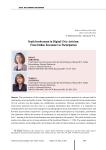
Youth involvement in digital civic activism: from online encounter to participation
Статья научная
The involvement of the younger generation in civic participation practices is a relevant task for youth policy actors and public activists. The digital environment not only expands the forms and directions of civic activism, but also designs new mobilization mechanisms. Network communities have a high involvement potential, but they exist in a saturated information flow. Therefore, it is important to understand how users encounter messages on socially significant issues and initiatives to address them, and how they react to them (“input level”: coming across an offer to participate in a civic project); and whether this experience affects the intensity of involvement in real practices of digital civic activism (“output level”: reacting in the form of participation/non-participation in the project). The article is based on the results of an online survey of young residents of the Sverdlovsk Oblast (n = 1150). The sample population includes students and working youth. According to the results of cluster analysis, we propose a typology of models showing how young people encounter the content about civic initiatives; we identify and describe three types: involved, superficial and scrolling readers. We provide a classification of resources that young citizens are subscribed to, in terms of their connection with issues of civic activism; we also reveal that subscriptions to specialized resources are closely connected with the typology of encountering this type of content. We reveal how young people react when they come across civic messages, and find out that they mostly show denying and interested reactions, while the amount of supportive and active responses is negligible. We build a typology of digital participation based on assessing the intensity of involvement. The share of those highly involved in the information field and real practices is 5%; the majority of respondents belong to the medium-active and low-active participants in civic activism.
Бесплатно

